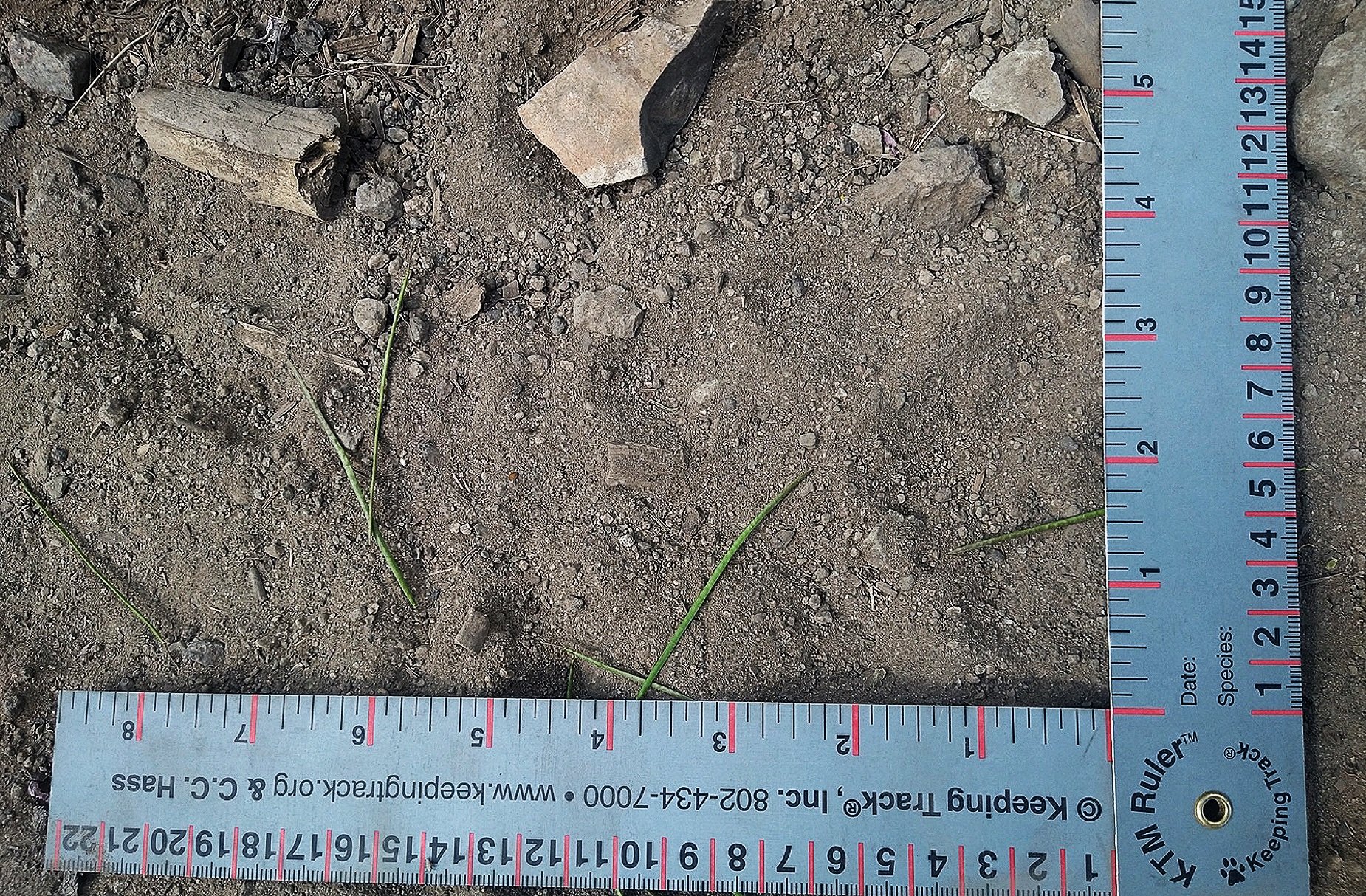Milton with new blank rounds and air horns for scaring wolves away from sheep in the area
Part of what makes this project special is the time spent trying to improve and understand the non-lethal conflict reduction systems we have in place. Early last week late at night I got a call Milton Jacobo, a shepherd with the Henslee operation, and he suspected wolves were preying on his sheep. . Those sheep had been in thick timber and had been pushed far downhill. In my experience, this behavior of sheep being scattered can be indicative of wolves being involved. It was too late to head out that night, so Lane and I went out bright and early the next morning, complete with flashing lights we planned to affix to the remaining spike Livestock Guardian Dog collars that the herders had. We brought extra sound-makers for them, in case the potential wolf activity continued.
Tracks heading up to the sheep coming from a distance away. We compared this print to the size of their livestock guardian dogs to confirm this was a wolf.
Despite being mid-July, the early morning cold of the wet, meadowed valleys bit our faces and our hands. We very quickly ran into very fresh, large canid tracks on the trail. Immediately, we suspected wolf due to the size of the track and the stride length. The tracks continued for quite some time down the trail, leading towards where the sheep were. I felt a bit worried, but Milton had told me he now had five Foxlights placed around the sheep and that they weren’t bedded down near where the first predation had occurred.
Field improvised livestock guardian dog protective collars with flashing lights attached.
Fortunately, nothing had occurred during the night. We were unable to confirm whether the three sheep had been killed by wolves as the carcasses were nowhere to be found. In hot weather like we had been having, carcasses very quickly deteriorate and make it very difficult to confirm a cause of death.
Still, to be extra safe we made these makeshift collars using the flashing ear tags that Dr. Julie Young has been using on sheep as a deterrent. Kurt Holtzen has been making a very similar collar design, but as he was still making his by hand, we hadn’t been able to get extras in time. We glued the flashing ear tags on the remaining collars the herders had on them and left them with the dogs
Going to verify that livestock guardian dog collars are functioning] and Foxlights had been placed.
Not having heard from Milton for a couple days, I returned with Jace Hogg from the Office of Species Conservation to show him how the Foxlights work and see how these collars were functioning. This time of year, it takes a while for the sun to go down, so we waited on the ridge overlooking the sheep, surrounding by fields of yellow lupine.
Foxlight placement verified!
Part of going out here was to see how the shepherds had placed the Foxlights, and fortunately it looked mostly all good. Milton had set up several along the ridge both east and west of where the sheep were sleeping. Their random flashing red, white and blue lights could be seen from quite a distance. Jace and I did find one Foxlight high in a pine tree making us laugh at the herder’s creativity and dedication, although they certainly don’t need to climb trees to put up the Foxlights.
As Jace and I waited for darkness, we heard a low bark starting in the background that sounded quite far away. Jace asked me what the dog was barking at and suddenly we heard a low howl sound off from down the ridge. At first it sounded similar to the low bark of the LGD, but after two more howls from the same animal, I looked at Jace and said “Yup, that’s a wolf.”
I didn’t have any noisemakers with me, so I tried making a loud clacking noise with my tongue. While it definitely wasn’t loud enough to have any effect on a wolf, it did upset the Livestock Guardian Dogs to no end. Suddenly, we watched three of them start running and barking at us from across the hill. As they did, the lights on their collars began flashing, showing us that the collars were indeed working! Feeling confident that the sheep were well protected with Foxlights and protective collars, and anxious to not disturb the dogs anymore, we slowly clambered up the hill to the truck. Once back at the truck, we sounded off an airhorn to add one more deterrent given how close the wolf was to the sheep band.
It ended up being a long, long day, but well worth our efforts. It is always important to ground truth how well our equipment is working, document any wolves in the area and ensure the Foxlights are being effectively placed. Being out there and trying to understand the issue on the ground is crucial to this work. Things on paper often look a lot different once they’re implemented in the field, and we are always looking to connect the two. We will continue to monitor the situation in this part of the Project Area[ to keep sheep safe and wolves alive, making sure the collars are working so that more predations aren’t occurring! No further incidents have been reported!
Happy howls,
Logan Miller





